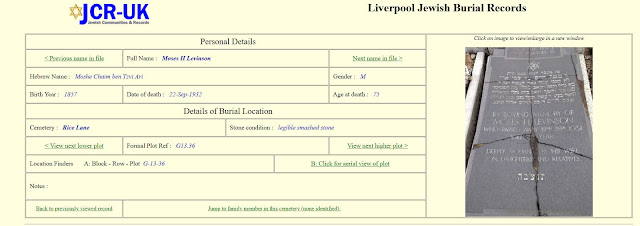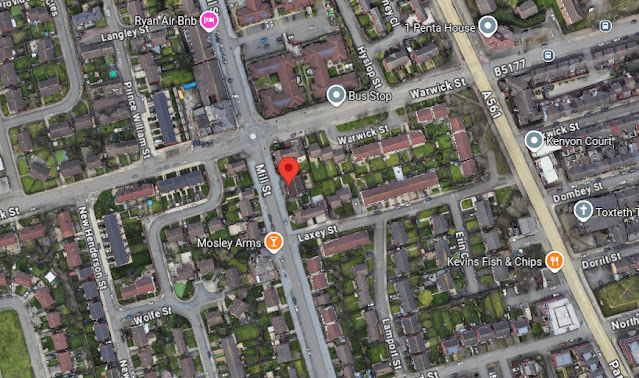Moses Hyman Levinson, is the father-in-law of Minnie Glynn, my 1st cousin 2x removed. Levinson family HERE. Glynn family HERE
Born: 1857 in Svislach or Svisloch (Belarusian: Свiслач, romanized: Svislač, Russian: Свислочь; Polish: Świsłocz; Yiddish: סיסלעוויטש), a town nowadays in the Grodno Region, Belarus
Hebrew name: Moishe Chaim son of Tzvi Arieh
Migration: Moses brought his family to England sometime between 1903 and 1908, age 46 to 51
Occupation: A picture framer, house furnisher and shopkeeper
Married: Hannah Rachel Zussman around 1884 in Svislach, nowadays Belarus. Moses was age 27 and Hannah age 20
Children
Their first child was born in 1886 when Moses was 29 and Hannah 22. Their last child was born in 1902 when Moses was 45 and Hannah 38
- Fanny Leah Levinson 1886 - 1960
- Maxwell Levinson 1896 - 1960
- Rachel Levinson 1896 - 1961
- Cecilia Levinson 1898 - 1957
Census details
1911
Moses and his family are living in a five room house at 147 Mill Street, Liverpool, England. Moses is age 52, a shopkeeper and house furnisher working on his own account at home. His wife Hannah is age 46. His children are Rachel age 16, Cecilia age 13 and Maxwell age 17
.jpg)
1921
The family are now living in a 5 room terrace at 7 Montpelier Terrace, Upper Parliament Street, Liverpool. Moses is age 62 and six months and a picture framer on his own account working out of a premises on 33 Park Place, Liverpool, Hannah Rachel is listed as Rachel and is 57 and three months. Cecilia is 23 and five months and a school teacher. Maxwell is 25 years and eleven months, an assistant manager and now an Argentine citizen and Fanny is now married, named Fanny Ruck age 36 years and eleven months
Directory
A 1911 Liverpool Directory where Moses Levinson, 147 Mill Street, is listed under House furnishers and Decorators
Death

22 September 1932 in Liverpool, England at age 75. He is buried in the Rice Lane Cemetery, Liverpool, England A Block plot no G-13-36

Liverpool Jewish burial record for Moses Levinson
Tombstone for Moses Levinson: He loved peace and pursued it. In loving memory of Moses H Levinson who passed away 22nd September 1932 aged 75 years. Deeply mourned by his wife, sons, daughters and relatives
Hebrew translation: "Here in this grave to rest lies the body of / Moshe Chaim son of Tzvi Arieh / swift as a deer and heroic as a lion pursuing God's will / how great and severe the pain – Moshe ascended heavenward / our sun[light] darkened and that very day the lights were extinguished / he did what was right in the eyes of the Lord and was of good spirit with his fellow man / he departed life on Wednesday 22nd of the month of Elul 5693."
The enlarged letters form the acrostic ר משה חיים. There is a problem with the Hebrew/English dates. 22nd September 1932 would have been 22nd Elul 5692, not 5693. But this was a Thursday not a Wednesday.
The Death registration index confirms that the year was 1932 and therefore the Hebrew date on the tombstone is incorrect
Place of Birth
SVISLOCH (Pol. Swisłocz ), town in Grodno district, Belarus; within Poland before 1795 and between the two world wars. A number of Jews settled there at the beginning of the 18th century on the invitation of the owners of the locality, the princes of Tyszkiewicz. In 1752 the Council of Lithuania imposed a poll tax of 215 zlotys on the Svisloch community, which numbered 220 in 1766. Until the middle of the 19th century the Jews of Svisloch earned their livelihood mainly from trade in timber and grain, shopkeeping, and crafts; they later also engaged in innkeeping and the lease of public houses. After a great fire, in which most of the Jewish shops were destroyed, the fairs were no longer held in Svisloch and the Jews were deprived of their principal sources of livelihood. Around 1870 Jews began to pioneer in the tanning industry and improved methods of manufacture with the assistance of German experts whom they invited. By the end of the 19th century a number of tanneries had been established in Svisloch, which employed hundreds of workers. Many Jews from the surrounding areas went there in search of employment. As early as the middle of the 19th century Jewish craftsmen in Svisloch attempted to organize themselves into guilds. At the beginning of the 20th century the Bund Movement developed in Svisloch and it embraced the whole of the Jewish working populace (tanners, tailors, shoemakers, carpenters. smiths, and bakers), who organized strikes for the amelioration of working conditions in tanneries and factories. In 1905 the workers' organization was established for Jewish self-defense against pogroms.
Residences
In 1911 the family were living at 147 Mill Street Liverpool. The house now shown here may date from after this period
In the 1921 census the family are living at 7 Montpelier Terrace, Upper Parliament Street, Liverpool, England L8. This Regency terrace, dating from the 1820’s, stood between Grove Street and Bloom Street and was demolished in the late 1960’s. This is a view of part of Montpelier Terrace taken in 1968. It is now the site of the Woman's Hospital
.jpg)



.jpg)



